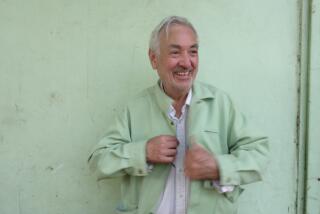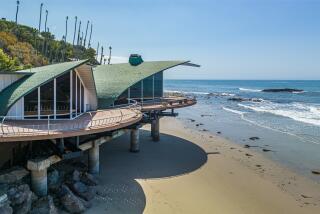Harry Seidler, 82; Architect Altered Sydney’s Skyline
Harry Seidler, an Austrian-born architect whose high-rise commercial and residential towers modernized the skyline and polarized the residents of his adopted hometown of Sydney, Australia, has died. He was 82.
Seidler had suffered a debilitating stroke in April 2005 and died at home March 9, according to a statement from his wife and fellow architect, Penelope Evatt Seidler, posted on his firm’s website. In addition to his wife, he is survived by a son, Timothy, and a daughter, Polly.
For the record:
12:00 a.m. March 18, 2006 For The Record
Los Angeles Times Saturday March 18, 2006 Home Edition Main News Part A Page 2 1 inches; 31 words Type of Material: Correction
Harry Seidler obituary -- An obituary of architect Harry Seidler in Wednesday’s California said the Bauhaus school of architecture and design originated in Austria. It was founded in Germany in 1919.
In a practice spanning more than 50 years, primarily in Australia, Seidler built single-family homes, apartment buildings and office complexes based on 20th century structural principles and materials.
“Harry’s buildings have changed the Sydney skyline,” Bob Nation, national president of the Royal Australian Institute of Architects, said in a statement on the organization’s website.
“Love them or hate them, they are an intrinsic part of the Sydney that we all know and appreciate,” he said.
Seidler’s innovative urban projects sought to tame the sprawl of postwar Sydney by providing high-density housing for residents closer to their jobs.
He carved out green space and public gathering spots within the boundaries of private developments that often soared many stories higher than any previous buildings to capture the spectacular harbor views that became increasingly prized by city dwellers.
His typically geometric structures of concrete, a cheaper alternative to other building materials, and glass reflected the sleek, spare style of the Bauhaus movement of his native Austria.
Born in Vienna on June 25, 1923, Seidler and his family, who were Jewish, fled the Nazi occupation in 1938. His parents, who eventually settled in Australia, sent their 15-year-old son to England. In 1940, after World War II started, he was interned as an enemy alien before being shipped off to another wartime camp in Canada.
After his release in 1941 he studied architecture at the University of Manitoba. Then, at Harvard, Bauhaus founder Walter Gropius instilled in Seidler an appreciation for the Modernist school of industrial design that strove to connect artists, architects and craftsmen.
After honing his skills with mentors Alvar Aalto at the Massachusetts Institute of Technology and Marcel Breuer in New York, Seidler moved to Australia in 1948 to design a home for his mother and father and establish his practice.
Seidler’s Australia Square was a landmark urban renewal project in the 1960s, replacing 30 squat buildings on a large block with one towering 50-story circular concrete structure.
At the base of the office complex, a plaza with fountains, trees and restaurant provided an oasis amid the central business district.
When Seidler’s 25-story Blues Point Tower Apartments went up in 1961 in a leafy harbor-side neighborhood, many criticized its monolithic proportions and declared the stark, rectangular box of a building incompatible with the neighborhood it dwarfed.
City planners blocked the construction of a cluster of other apartment towers, sparking a decades-long debate between the prickly architect and those who could approve his designs.
“What happens in Australia is the equivalent of the hospital orderly telling the surgeon how to operate,” Seidler said in a 2000 lecture at Sydney University.
But by then many Seidler buildings had been approved and completed in Australia as well as had the Australian Embassy in Paris and high-density complexes in Acapulco, Hong Kong and Vienna.
He was awarded the Gold Medal of the RAIA, Australia’s top architecture prize, in 1976 and was honored with the Royal Institute of British Architects’ Gold Medal in 1996.
Two years later Seidler told Sydney’s Daily Telegraph in a written question-and-answer session that the best judges of the art of architects are “the users of buildings.”
Last weekend Nathan Jones, a resident of the Blues Point Tower, described for the Daily Telegraph the highlight of living there: the rooftop laundry facilities.
“It’s the most fantastic view to do the washing,” he said.
More to Read
The biggest entertainment stories
Get our big stories about Hollywood, film, television, music, arts, culture and more right in your inbox as soon as they publish.
You may occasionally receive promotional content from the Los Angeles Times.










